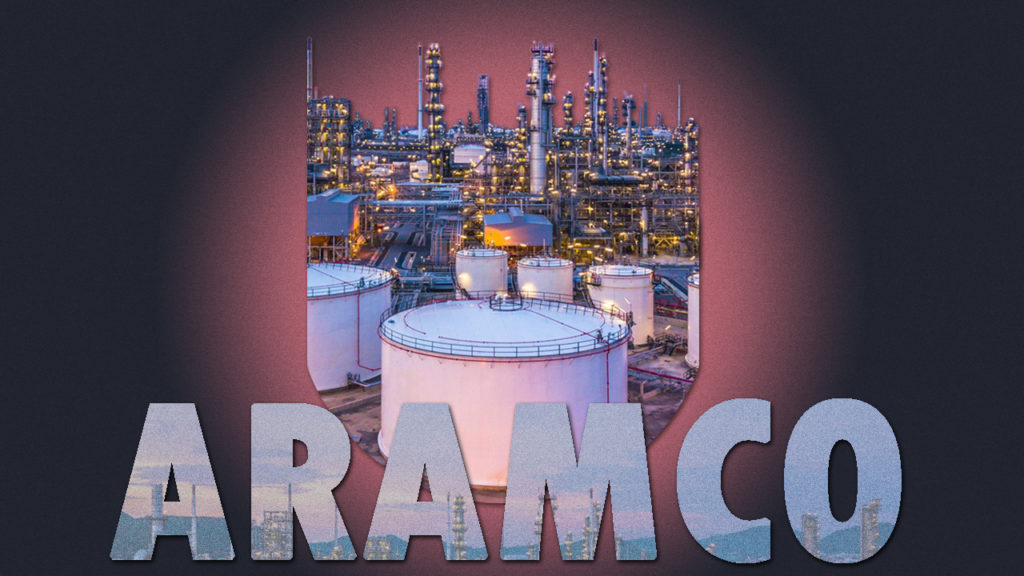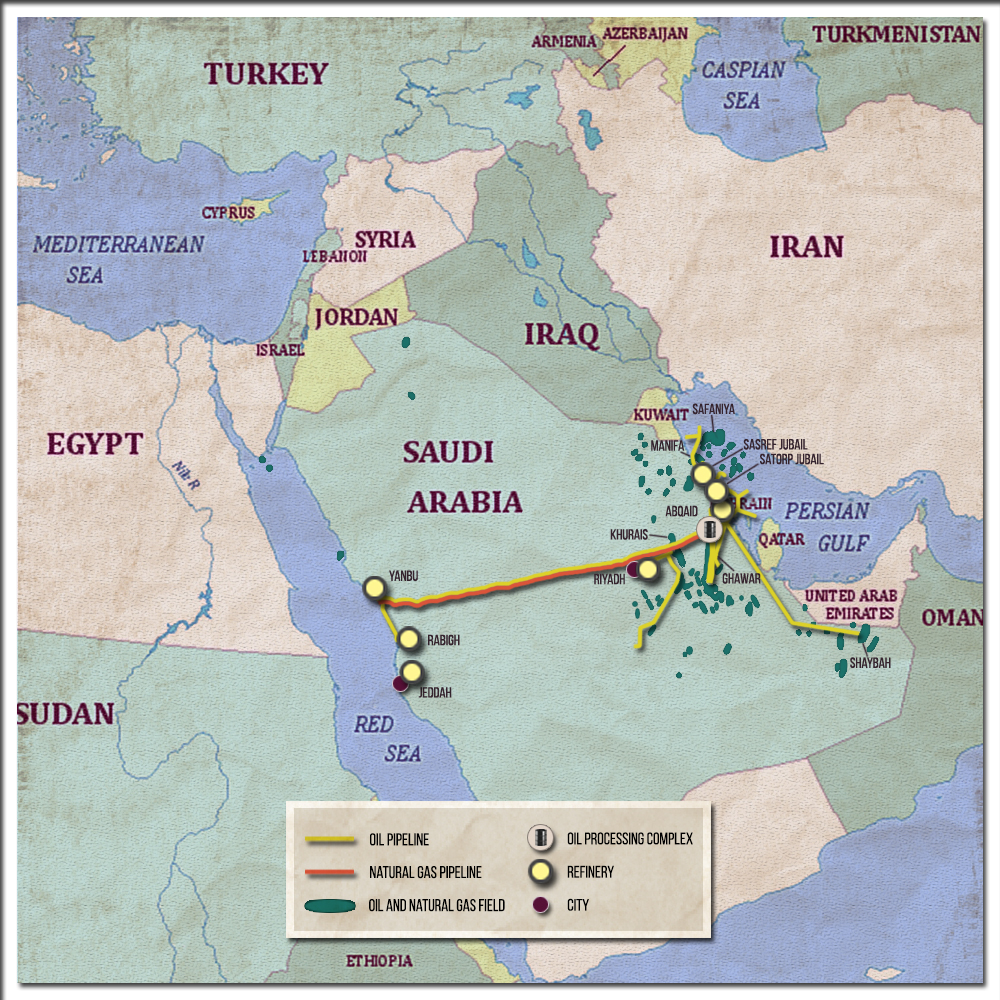With the current all-out oil price war, a central role is played by Saudi Arabia, and its state-owned company Aramco. The company is currently offering unseen discounts, and flooding the market with its crude oil, in an attempt to snatch a larger market share and push its competitors into loss. MORE HERE
Saudi Aramco, officially called the Saudi Arabian Oil Company (formerly the Arabian-American Oil Company). The company is entirely state owned by the Kingdom’s government and is the biggest producer of oil on the planet. It is officially based in Dhahran, Saudi Arabia and has an estimated 270 billion barrels in reserves.
It was formed as the product of a Concession Agreement between the Saudi Arabian government and Standard Oil Company of California (SOCAL) in 1933. Aramco began its first drilling operations shortly after, starting its first commercial oil production in 1938.
In 1973, the Saudi Arabian government purchased a 25% interest in Aramco, gradually increasing its stake to 100% in the late 1970s.
Saudi Aramco is led by Amin H. Nasser, its president and CEO. Khalid Al-Falih, chairman of Aramco, was appointed Saudi Arabia’s energy minister in 2016.
The oil company pays a tax rate of about 50% to the Saudi Arabian government, comprising a large share of total revenues from 2015 to 2017. Funding has allowed the company to begin investing in ambitious long-range projects, like smart cities.
It is being run as a commercially independent company, with the government’s budget is highly reliant upon contributions from Aramco in the form of royalties, taxes and dividends. It is by far the world’s most profitable company, eclipsing even tech giants such as Apple Inc. and Alphabet Inc.
This was revealed in April 2019 when ratings agencies released financial information of the long-secretive company before its debut international bond sale, which raised $12 billion.
In September 2019, Saudi Arabia oil facilities came under a powerful drone attack:
Aramco operates differently than the public companies everybody is familiar with.
Saudi Arabia is the primary swing producer in the Organization of the Petroleum Exporting Countries (OPEC), cutting oil production to prop up prices and balance markets when needed.
It also keeps oil production capacity in reserve to call upon in times of shortage.
These decisions are made for market stabilization and political reasons; a company focused on maximizing shareholder value would be unlikely to act in this way.
The decisionmaking process will not change in the wake of the IPO.
Saudi Aramco began to attract increased investor attention in 2016, when Saudi Crown Prince Mohammed bin Salman announced plans to list 5% of Aramco at a valuation of approximately $2 trillion in what may be the largest IPO (Initial Public Offering) ever.
For the first half of 2019, the oil giant reported a profit of $46.9 billion, which is a fall of 12% from the same period in 2018. The given reason was low prices and reduced output.
On December 11, 2019, shares amounting to 1.5% of Aramco’s value began trading only on the Tadawul, Saudi Arabia’s stock exchange.
The IPO will raise nearly $26 billion for the kingdom, at a price that values Aramco at $1.7 trillion.
The Saudis postponed the IPO a number of times, but a management shake-up in September 2019 was the first step in getting the process moving again. The push for progress on the IPO was derailed in mid-October, when bankers informed Aramco management and Saudi officials that international investors were expected to value the company at between $1.1 and $1.7 trillion.
Transparency and valuation have been the biggest challenges since the Aramco IPO was announced nearly four years ago.
In September 2019, an Iran-blame attacked damaged Aramco’s oil facilities and could have led to global shortages in demand, if spare capacity and a rapid repair program were not employed.
The reduced valuation of Aramco was the final straw that ended the kingdom’s dreams of a huge international IPO. Citizens feel a sense of pride in Aramco as their national champion and the heart of their economy, making the stock attractive to local buyers, and the Saudi government offered incentives to local buyers.
When it came to the market, Aramco stock initially spiked, reaching the Crown Prince’s sough-after $2 trillion valuation. Aramco shares have since faced new pressures from heightened tensions in the Gulf region. Aramco’s market cap now stands at about $1.86 trillion, as of mid-January 2020.
For the first time since the its listing, Aramco’s shares fell down under the initial IPO on March 8th, to $8.24, by 6.36%. This was a direct result of the oil price war initiated earlier, following the failure of OPEC+ to negotiate lower production from April 1st onwards. Saudi Arabia launched unprecedented discounts and began flooding the market in an attempt to capture a larger share, so that it could secure its revenue that supports the Riyadh government.
Starting from April 1st, Aramco is expected to increase its output to 10.3 million barrels per day, or even closer to 11 million. Its current output is 9.7 million, and the entire Saudi capacity stands at 12.5 million.
Up until now, OPEC+ has been effectively cutting production by 2.1 million bpd, as Saudi Arabia has been reducing its own output by more than agreed.








Let’s look closer at oil ownership, Kuwait/Saudi have joint ownership of most productive oil fields, and while Saudis have vast numbers of wells it is numbers of wells that keep its production numbers high.
Saudis when they Gained full control began massive over production of their then present fields, a process began under old foreign owned fields, and at rates that dained pools beyond their old seepage rates so that they have to pump water into them today which raises cost to about 4,5 to 6,3 barrels of contaminated to get 1 barrel for sale.
It does still have vast reserves, richest and least costly to pump areas being in Kuwit partnered fields.
Saudi fields are most modern in world but the tech cost of hiring foreign experts , is not reported but known to industry.
It is not foreign oil production driving Saudi concerns, it is the far greaterngas fields owned by Iran and Qatar that threatens their financial futures, that and gas from US Brit/Canada fields LP exports.
If one follows Saudi debt to GDP ratio one finds Saudi debt growing at over 10% per year
The debt level increases made the sale of 5% of holdings to mostly those firms who used to own its oil, necessary, and while at same time reducing Sovereign investments, selling off many, to pay for its 10s of billions cost of warmaking..
Their need for Saudis’ keeping high prices for oil was just undercut by worlds least costly oil producer and it’s refusal to cut back production. by Russia.
This article reads like an investor’s sales portfolio, lots of gloss bull crap that hides real reasons their need for investors.
Family feuds came about because of too many hands in the pie reducing the take due to sheer number of bloodlines doing nothing to earn it.
Consolidating funds by reducing other familys take is only way Saudi nation can fend off political powers outside of nation; powers their old immense wealth allowed them to bribe their way into thinking they had real power.
They, Royals fell into same pit as all Royal Dynasties of past, they began believing own BS that they were gods.
Many of their family members no longer live in Saudi Arabia, preferring to live off familys oil wealth in much more decadent Euro/ Brit and US societies where everything is for sale and with Saudi Royals dependent on foreign labor, military of commanders of mercenary forces and oil experts, life is becoming far more complicated for Saudi gods.
Saudi Arabia had nine new cases of coronavirus this weekend and decided to quarantine Qatif – not the city, but the entire governorate (province). I wasn’t sure how big the governorate itself is, so I checked. Here ya go:
https://uploads.disquscdn.com/images/1d60717e50f77da5d7cfecadf37bf7163e878ee843cb82aa76d4fcb60003f81c.png
That would be the entire eastern half of Saudi Arabia – mostly Shia and nearly all oil production. Nobody can enter or exit the province according to reports. It’s not clear if that just means without being checked (temperature) or if it’s a total lockdown, but Shia are no longer being allowed to travel to/from Iran. That’s kind of a problem. Especially if most of your local oil labor are Shia. The government also closed down all public and private institutions except for ‘necessary services’. CENTCOM ordered thousands of US troops just stationed there to die if necessary to protect the al Saud rulers and their corrupt government from the Saudi people. I expect the riots there to start in 4… 3… 2… 1…
Oil production? As always, ignore what the Saudis say and look at the sulphur dioxide surface mass spewing from the refineries. Looks about normal for the start of the work week so far. If levels start dropping, the Saudis are screwed. Incidentally, you can spin the globe over to Wuhan/China and see that they’re producing the usual toxic clouds of SO2, so I can’t imagine a lot of factories are closed. China’s SO2 (at least in Wuhan) is from burning natural gas for power. Or burning virus-riddled corpses. You’re call.
https://earth.nullschool.net/#current/chem/surface/level/overlay=so2smass/orthographic=45.52,23.71,1866
they are screwed thats all that matters hahahaha
Saudi bankrupt economy will collapse and internal unrest will grow as subsidies to the lazy morons are cut. The lost war in Yemen is now literally a nightmare.
that’s around 5% of the pop
OPEC + has the plus as Russia. They have denied to lower their production.
It wasn’t too long ago we were being told that saudi wells are drying up and they simply did not have the capacity reported.
In turbulent times such as these, suadi’s need to keep a cool head, either in the fridge or out on display.
The dumbass Saudi’s IPO was the most moronic idea at a time the world is past peak oil and there is a lot o investment in alternate technology. Secondly, and perhaps most importantly Saudi morons are engaged in a geo-strategic tussle with two of the strongest and canniest nations on earth Russia and Iran.
Saudi Arabia with a weak one trick pony economy and Russia a superpower with a technology based diversified dug in for a long and destructive price war, as Moscow responded to Riyadh’s opening salvo in coordination with other OPEC heavyweights like Iran and Iraq.
If there was any doubt that the collapse of last week’s OPEC+ talks had created a lasting rupture between the world’s top crude exporters, was confirmed this week as Russia’s largest producer Rosneft PJSC who will pump significantly more oil next month, retaliating for Saudi Aramco’s steep price cuts.
The Kremlin didn’t flinch in the face of the conflict’s initial toll: the biggest price plunge since the end of the 1991 Gulf War; hundreds of billions wiped off oil-company valuations; soaring bond yields in
resource-dependent nations.
That’s just day one. A prolonged struggle between the two unequal powers – with each seeking to maximize the price pain for their foe by pumping as much as possible – could inflict lasting damage on the industry that produces the world’s most important commodity. The Saudis already facing a military quagmire and growing unrest at home are far more susceptible that Russia, the world’s largest resource rich nation and a nuclear power with a diversified economy and global strategic reach.
The ruble got hit 8% yesterday but recovered 5% today.. So the panic seems to be over.. Russia also hold a lot of gold and is not selling of strategic assets like they were before.
Saudis are in the wrong league and will be the ultimate losers.
MBS gave a great to the global economy during this current crisis.
Let’s hope this price war continues as long as possible.